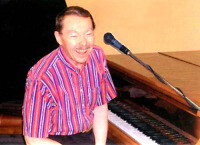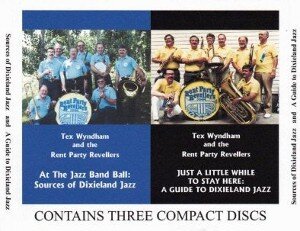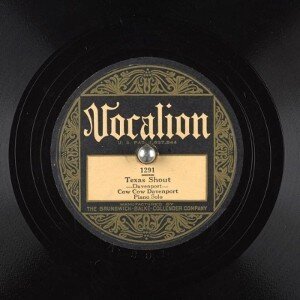 Set forth below is the fifty-fourth “Texas Shout” column. The concluding installment of a two-part essay, (part 1,) it first appeared in the September 1994 issue of West Coast Rag. now The Syncopated Times. The text has not been updated.
Set forth below is the fifty-fourth “Texas Shout” column. The concluding installment of a two-part essay, (part 1,) it first appeared in the September 1994 issue of West Coast Rag. now The Syncopated Times. The text has not been updated.
Several of you have asked me to explain the onstage signals that I use to call routines during performances by combos I lead. Actually, variations of most of these devices are in rather common usage among bandleaders and, I would think, shouldn’t be hard to figure out by someone in the audience who pays close attention. Thus, I doubt that most of you would be interested in a detailed description thereof.
However, a brief discussion of the basic philosophy behind these techniques might give general readers a little better understanding of what’s happening on the bandstand and thereby enhance their enjoyment of our music. Maybe it will get a few bandleaders thinking about ways to keep their own presentations fresh. Anyway, here goes.
The Rent Party Revellers have one ground rule regarding onstage routines. It is my job to get the signal to each sideman. No Reveller is supposed to drop out, or re-enter, just because he hears someone else do so. He/she has to get the word from me.
With that lead-in, the Revellers’ hand signals operate to cue the band regarding the number of choruses to play, which musicians are to be playing at any given time, and (in two instances) when a pre-set subunit of the band is to perform. In addition to those, I have a set of signals, some verbal, some by hand, to tell the drummer what kind of ending to use.
If the cornetist and drummer in a Dixieland band know what kind of ending is coming up, they can structure what they play to cue the other musicians to end the tune accordingly. I won’t outline each of those signals, but they provide methods to end tunes in about six or seven ways. Using a variety of endings makes it appear that the band is employing arranged passages but leaves the freedom to get right up to the closing bars before settling on the ending that’s the “right” one for that particular tune on that particular day.
As for verbal signals, at the start of the tune, when it’s quiet, I can easily cue the number of opening pickups, at which point the trombone, piano and tuba will know just what to do. Also, that’s a good time to cue the first solo, or maybe the first two.
We have a few other basic understandings that we’ve developed over the years. However, the ones described above will do for purposes of today’s discussion.
There really aren’t a lot of them, and most are fairly obvious. Indeed, the average combo is likely to use most of them to some extent at one time or another.
(There is one exception to that statement. Some combos use various numbers of fingers pointing up or down as a way of indicating keys.
The Revellers don’t do that because, with few exceptions, we don’t change keys for a given strain during a performance. We believe we can get enough different things going by regrouping our eight players without spontaneous key changes. Thus, we feel free to use these standard “key change” signals for other purposes.)
If you’ve occupied a stageside seat during a Revellers’ set, you’ll hear me tell the band at the start how we’ll get into the tune, and who will be playing during the first solo chorus. After that, most of the time, nobody, not even me, knows for sure what will be happening. At each step, though, we try to build on what’s gone before while steadily striving to show the audience a fresh framework for the tune.
It’s a risky way to operate. However, in my opinion, taking chances is a sine qua non of creating the best jazz. Not all chances work, but when each sideman is on his toes, ready for the next challenge, you’ll find that more of them work than otherwise. Further, because surprises can occur, everyone – musicians and audience – gets caught up in the process.
Dick Shooshan told me once that he’d heard it said that the best jazz is played right on the brink of disaster. I couldn’t agree more. If you only listen to bands that never take chances, you’ll never hear any wrong notes or the type of mix-up that jazzmen call a “train wreck,” but you probably won’t hear any truly great jazz either.
In the dozen or so years that the Revellers have been exposing these devices on the circuit, I think I’ve seen some bands increasing their spontaneous use of subunits and other changes in tone combinations. However, I haven’t yet seen a band that regroups the musicians as often or as radically as we do.
I sometimes wonder why not. Have today’s Dixielanders become so conditioned to the sounds on their favorite records that they are afraid to try any others?
Don’t other bandleaders become curious, for example, about what might happen if the next chorus were a tuba solo accompanied only by the clarinet and cornet? Or a trio of clarinet, alto and banjo? Or the trombone and clarinet (with full rhythm) taking turns backing each other’s solos on the first and second half of the chorus? Or front line only with the rhythm entering on the first beat of the second half of the chorus?
The possibilities are literally endless. Some of them turn out so gloriously that the thrill sticks in your mind for years.
(See: Texas Shout #30 Introducing Creativity and Imagination to your Band)
There is one catch, however. To make such wide use of spontaneous effects, the leader needs to learn how to think several choruses in advance. It took me quite some time of working with the Red Lions to get used to doing so.
You need to think far ahead because, for example, if you believe it might be interesting along the way to try an unaccompanied tuba solo, followed by an unaccompanied saxophone-tuba duet, then an unaccompanied clarinet-saxophone-tuba trio before breaking the tension with a trombone solo with full rhythm, you can’t wait until the performance is half over before getting into the sequence. You’ll have already used up too many of your soloists and lost the chance to build the ride properly.
Also, you can’t organize a routine like that one with just two or three bars to go. You need to start doing so while there’s time to get everyone properly cued. Otherwise, the execution will be sloppy.
Even after all these years, when I’m leading a band on stage, I’m concentrating exclusively on the routine once the rendition begins. That’s one of the reasons why I don’t play cornet solos. I’m too wrapped up in keeping things on track.
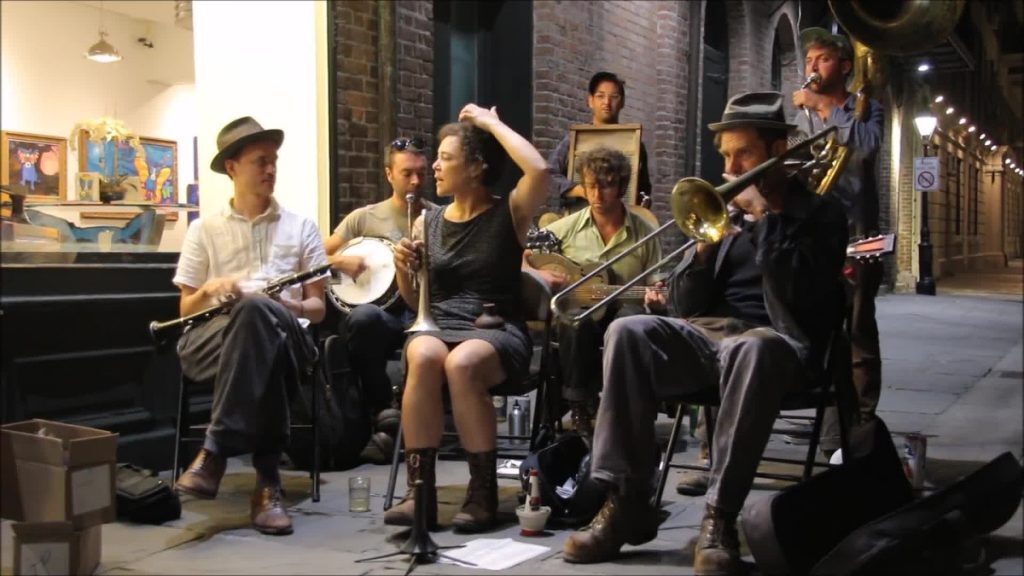
(If you hear me playing cornet without one of the other front line horns playing, it’s always part of a special effect, either a chase or a subunit. I’ve never particularly sought this somewhat left-handed distinction, but I’ll bet I’m the only cornetist who’s been with a major festival/cruise band for over ten years and who’s never played a full-chorus improvised solo backed by the entire rhythm section.)
The Red Lions could probably tell you piles of stories about how oblivious I get to anything that isn’t a part of the music happening onstage. For example, in our early days, a patron had a heart attack and died while we were playing a restaurant gig. Once the commotion had died down and we prepared to resume, I was about to announce the next tune on our preplanned list when the pianist leaned over, tapped me on the shoulder, and suggested that maybe it wouldn’t be quite comme il faut to kick off “After You’ve Gone.”
Most of you haven’t seen the Red Lions. However, let me wrap up this somewhat technical discussion on, I hope, a light note by relating a couple of instances that some of you witnessed.
I was leading a jam session at a festival, the band comprised of wonderful players, all friends of mine and good-hearted people. It turned out that they had arranged to play a practical joke on me during our set-closer by ignoring my signals; instead they followed routines cued behind my back by one of the other sidemen. Quite a bit of the audience, in fact, was in on the joke before we took the stage.
I’m afraid I rather flattened the event without meaning to. I was, as usual, thinking so far ahead on the ride that I was unable to bring myself to do anything other than try frantically to straighten out what I perceived as missed cues caused by my own failure to communicate properly.
I remained in that confused state until the performance struggled to its conclusion. Once offstage, with the pressure off, I realized right away that I was being given a friendly leg-pull.
The second occasion is an instance that just got funnier the longer I remained in my cloud. It occurred during the last Revellers’ set at the 1992 San Diego festival.
The next group at the venue was Dick Shooshan’s Golden Eagle Jazz Band. Though Dick was, naturally, playing with the Eagles that weekend, he is also, as mentioned above, one of the Revellers’ pianists. I thought I saw Dick enter the hall and wanted to call him up to sit in, but all of a sudden he seemed to have disappeared.
It turned out that Dick had worked his way around the room’s perimeter, getting up to the bandstand without my seeing him and taking over the keyboard from Ed Metz halfway through our next-to-last tune. Now Dick and Ed are both great players, but their styles are very different. Most leaders would have heard the difference right away.
Nevertheless, because nothing was going wrong, and because the piano solo had already been played by Ed, I did my usual thing and concentrated on working the other sidemen through various combinations until we finished. Then, still wondering what had happened to Dick, I announced the closing number and counted it off.
Ed, meanwhile, was standing right by the stage in full view of me and of the audience, which was chuckling away at my single-mindedness. We started the last tune, at which point Ed, still without his presence registering on me, started walking back and forth in front of the bandstand, about two feet in front of my horn.
Finally, it came time to cue the piano solo. I turned to discover Dick, rolling it out with a big smile on his face, and the audience in gales of laughter. I can still hear Dick saying, as I was packing up after the set, “Man, are you FOCUSED!”
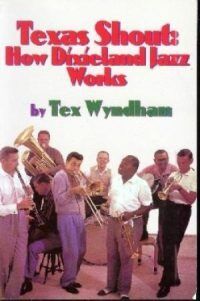 Want to read ahead? Buy the book!
Want to read ahead? Buy the book!
The full run of “Texas Shout” has been collected into a lavishly illustrated trade paperback entitled Texas Shout: How Dixieland Jazz Works. This book is available @ $20.00 plus $2.95 shipping from Tex Wyndham, On request, Tex will autograph the book and add a personalized note (be sure to tell him to whom the note should be addressed).
Tex Wyndham’s 3 CD Guide to Dixieland with music and commentary is available for $20 plus $2.95 shipping. The separate CD, A History of Ragtime: Tex Wyndham Live At Santa Rosa, is available for $13.00 plus $2.00 shipping. On request, Tex will autograph the inner sleeve and add a personalized note (be sure to tell him to whom the note should be addressed).
Send payment to Tex Wyndham, P.O. Box 831, Mendenhall, PA 19357, Phone (610) 388-6330.
Note: All links, pictures, videos or graphics accompanying the Shouts were added at the discretion of the Syncopated Times editorial staff. They did not accompany the original columns and do not necessarily reflect the opinion of Tex Wyndham.
From roughly 1970-2010, Tex Wyndham was: (1) one of the best-known revivalist Dixieland jazz musicians in the US, as cornetist, pianist and bandleader, (2) one of the best-known ragtime pianists in the US, and (3) one of the most respected critics in the US of Dixieland jazz, ragtime, and related music. He is the only person about whom all three of those statements can be made.

